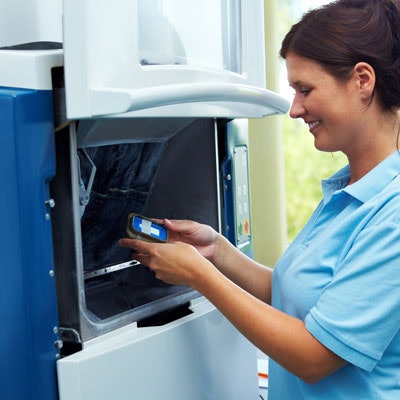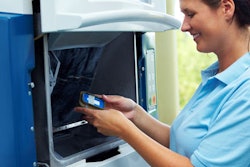
When creating restorations using a CAD/CAM system, material options include a glass-matrix ceramic and a resin composite. However, newer materials may offer more strength and hardness. Researchers put five of these newer materials to the test.
Researchers from Turkey wanted to see how these materials differed when put through a process that simulated conditions in the mouth. The so-called ceramic-resin composite materials did not hold up as well after this aging process, they reported in BMC Oral Health (January 8, 2018).
"The present study showed that ceramic-resin composite materials are not superior to all types of glass-matrix ceramics in terms of flexural strength," wrote the study authors, led by Nesrin Sonmez of the dental prosthesis technology department of the dental services division of Beykent University Vocational School in Istanbul.
Flexural strength issues
While glass-matrix ceramic materials and resin composite materials are often used for restorations because of their mechanical and optical properties, both materials have several drawbacks. Glass-matrix ceramics can be brittle and abrade on the opposing teeth because of their hardness. Resin composites may suffer from wear, missing surface polish, and a lack of color stability.
Hence, newer restorative materials, such as polymer-infiltrated ceramics and nanoceramic resins, have been developed. But how do these materials hold up under strength and hardness testing?
The researchers wanted to evaluate the characteristics of five CAD/CAM materials through mechanical analysis. They focused on three initial ideas:
- Polymer-infiltrated ceramics and nanoceramic resins would have a higher flexural strength compared with glass-matrix ceramics.
- Polymer-infiltrated ceramics and nanoceramic resins would have lower Vickers hardness and fracture toughness values compared with glass-matrix ceramics.
- The resins and ceramics would be more affected by thermocycling compared with glass-matrix ceramics.
The researchers tested five different CAD/CAM blocks (n = 22 in each group):
- Vita Enamic (Vita Zahnfabrik), a hybrid ceramic material
- Lava Ultimate (3M), a resin nanoceramic material
- IPS e.max CAD (Ivoclar Vivadent), a lithium disilicate-based glass-matrix ceramic material
- IPS Empress CAD (Ivoclar Vivadent), a leucite-based glass-matrix ceramic material
- Vita Mark II (Vita Zahnfabrik), a feldspathic glass-matrix ceramic material
The team subsequently divided each group of blocks into two groups of 10 blocks and subjected one group of 10 specimens to 30 seconds of thermocycling (an in vitro process of subjecting a restoration to different temperatures similar to those in the oral cavity) while the other group was not.
The researchers tested all the blocks in terms of flexural strength, Vickers hardness, and fracture toughness. They found the highest Vickers microhardness value for VITA Mark II (p < 0.001); however, this material also had the lowest flexural strength (see tables below).
| Hardness of restoration materials | |||
| Material | Material type | Hardness before thermocycling | Hardness after thermocycling |
| Vita Mark II | Glass-matrix ceramic | 6.4 | 6.3 |
| IPS Empress | Glass-matrix ceramic | 6.1 | 6.1 |
| IPS e.max | Glass-matrix ceramic | 5.8 | 5.8 |
| Vita Enamic | Hybrid ceramic | 2.3 | 1.9 |
| Lava Ultimate | Resin nanoceramic | 1.1 | 0.8 |
The three glass-matrix ceramics had higher Vickers hardness values before and after thermocycling.
The IPS e.max CAD had the highest flexural strength (p < 0.001) (see table below). Measurements are in megapascals (MPa), which measures the force per unit area.
| Flexural strength of restoration materials | |||
| Material | Material type | Strength before thermocycling (MPa) | Strength after thermocycling (MPa) |
| IPS e.max | Glass-matrix ceramic | 359.2 | 357.7 |
| Lava Ultimate | Resin nanoceramic | 191.2 | 140.4 |
| Vita Enamic | Hybrid ceramic | 152.1 | 111.1 |
| IPS Empress | Glass-matrix ceramic | 134.5 | 134.7 |
| Vita Mark II | Glass-matrix ceramic | 112.4 | 112.1 |
The Vita Mark II had the highest fracture toughness in the testing (see table below). Measurements are in megapascals multiplied by meters1/2.
| Fracture toughness of restoration materials | |||
| Material | Material type | Before thermocycling (MPa x m1/2) | After thermocycling (MPa x m1/2) |
| Vita Mark II | Glass-matrix ceramic | 2.34 | 2.33 |
| IPS Empress | Glass-matrix ceramic | 1.90 | 1.88 |
| IPS e.max | Glass-matrix ceramic | 1.67 | 1.63 |
| Lava Ultimate | Resin nanoceramic | 1.29 | 1.10 |
| Vita Enamic | Hybrid ceramic | 1.23 | 1.02 |
The flexural strength and the fracture toughness of the ceramic-polymer composite materials (Vita Enamic and Lava Ultimate) were significantly decreased after the thermocycling process, the researchers noted.
Looking back on their initial ideas, they thought that the polymer-infiltrated ceramics and nanoceramic resins would have a higher flexural strength than the glass-matrix ceramics. This turned out not to be true, as one of the glass-matrix ceramics (IPS e.max) had the highest flexural strength measured.
However, their other ideas were confirmed, as the ceramic-polymer composite materials had lower Vickers hardness and fracture toughness mean values than the glass-matrix ceramics, and the ceramic-polymer composite materials were affected by thermocycling.
Aging process
The authors listed three possible limitations of their study:
- The applied aging method, thermocycling, is only one possible aging method and other methods might produce different results.
- They only used one shade and translucency for each tested material.
- The study had a small sample size.
While the authors were reluctant to endorse any one material, they noted that one set of materials seemed to come out of the aging process worse for wear.
"It should be realized that [the] simulated aging process seem[ed] to affect ceramic-polymer composite materials more significantly than glass ceramics," they concluded.



















